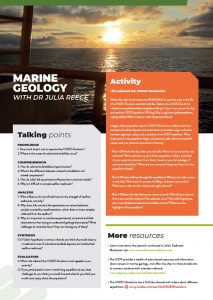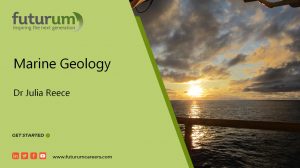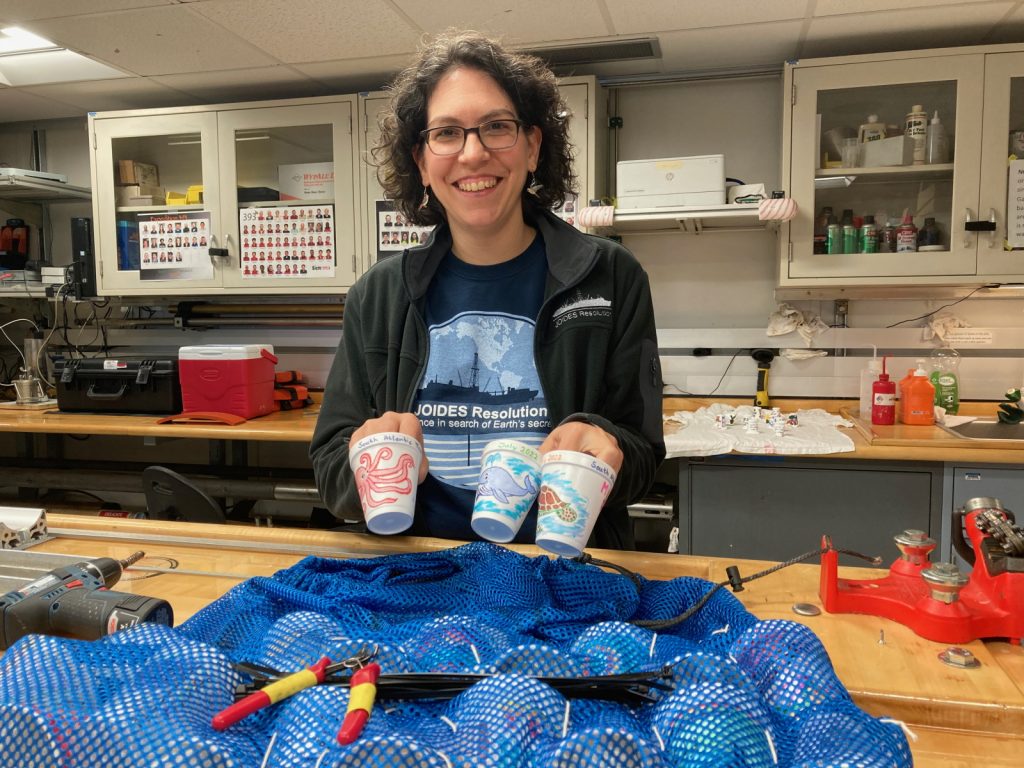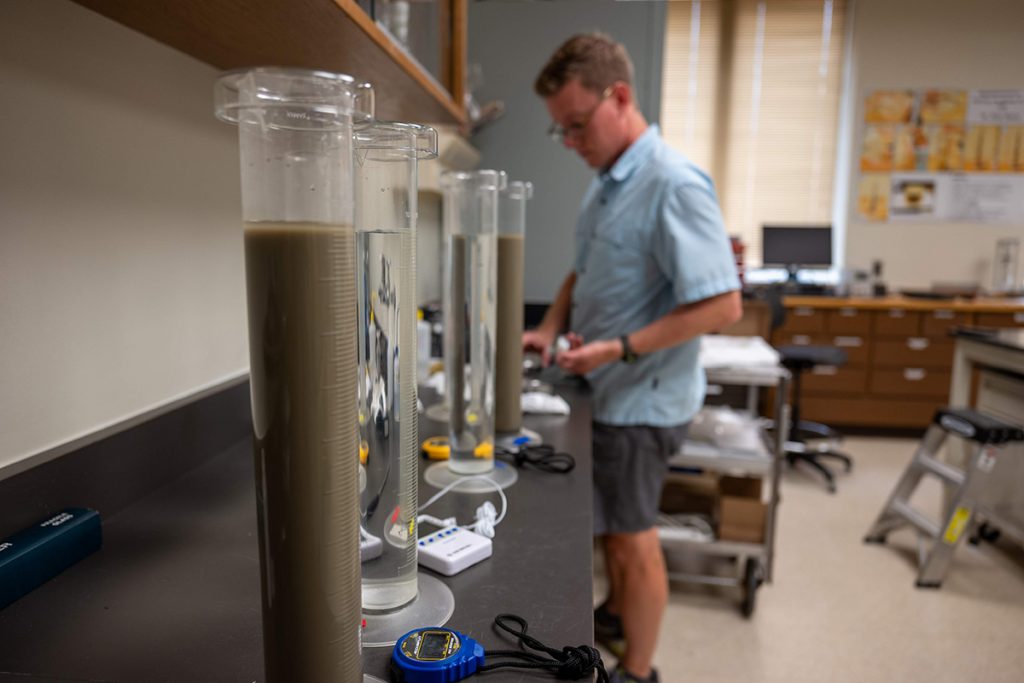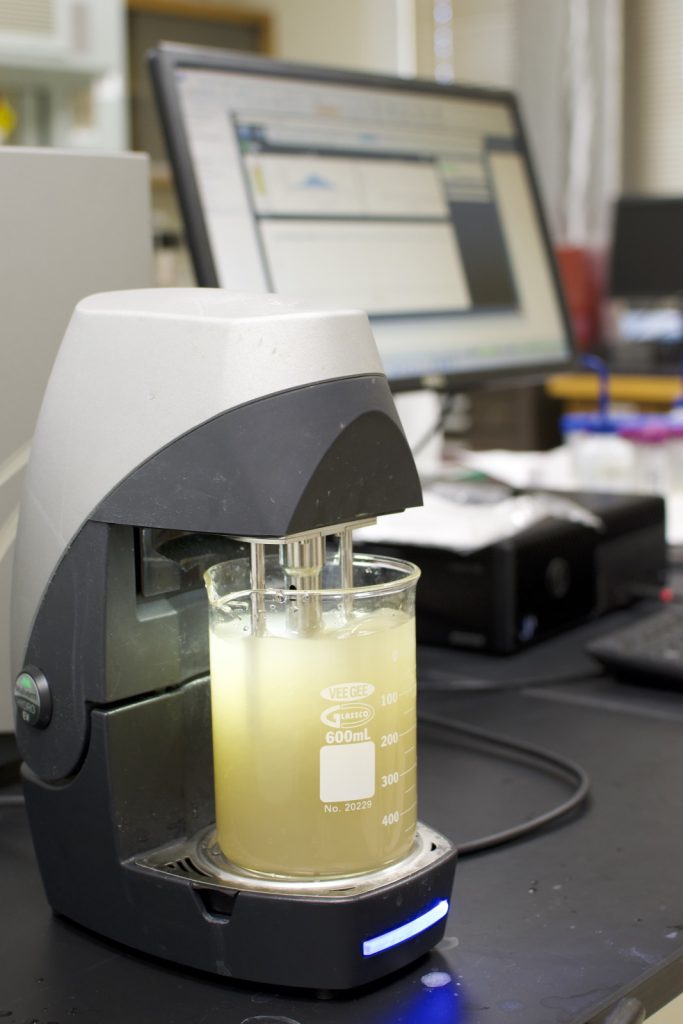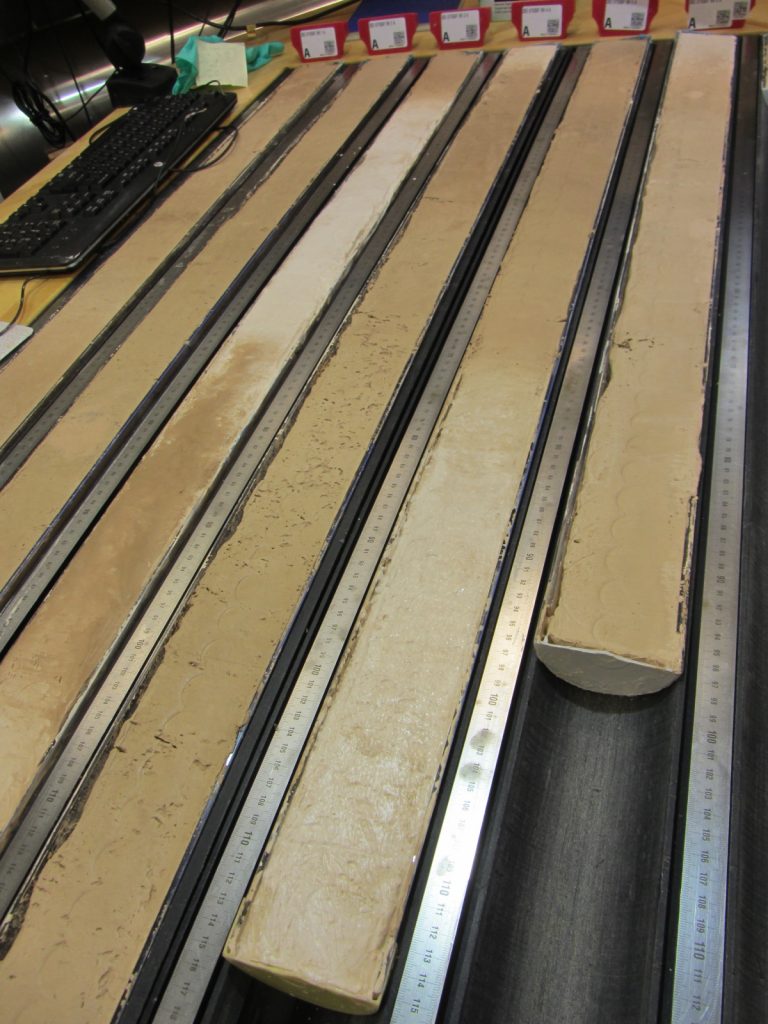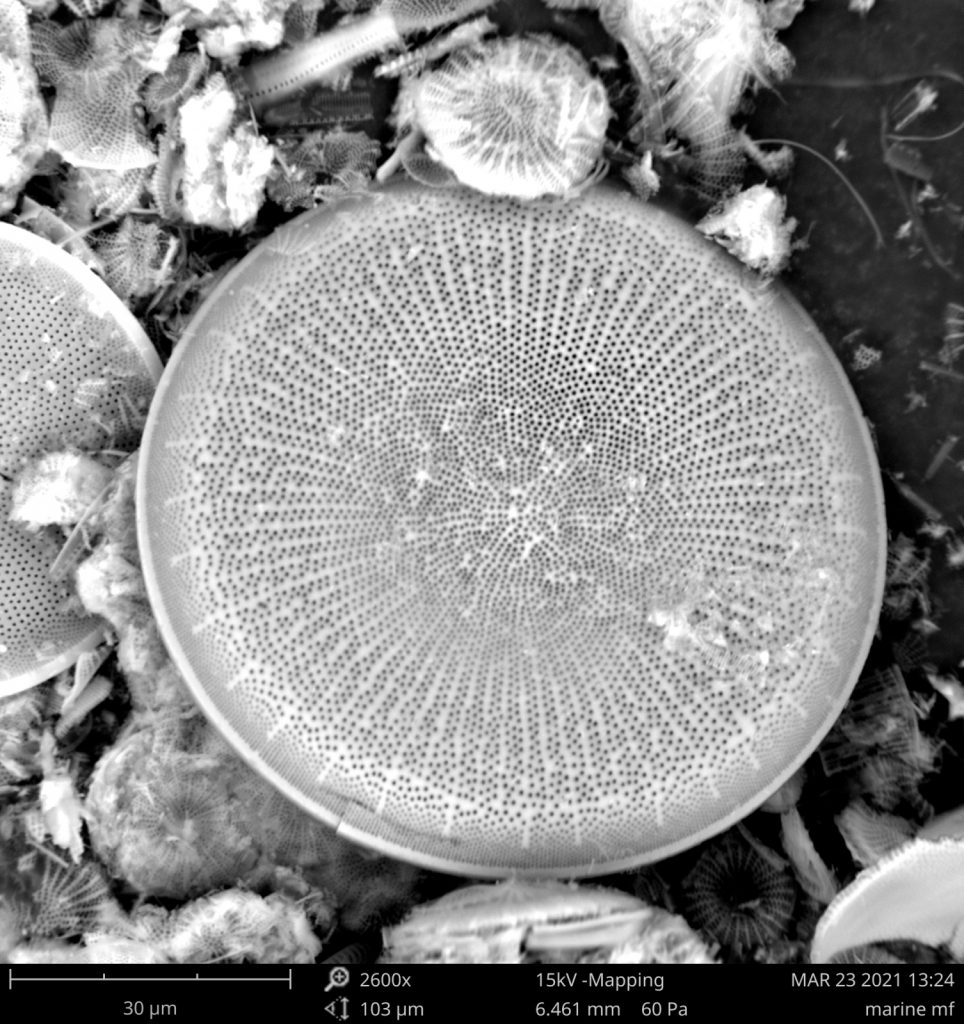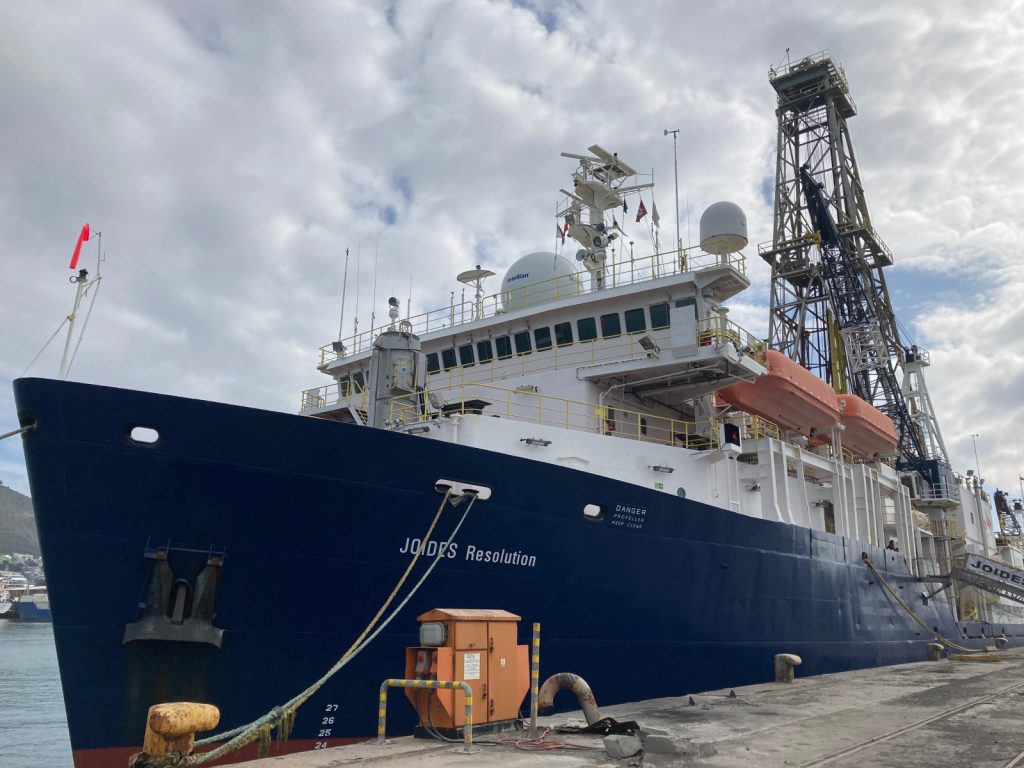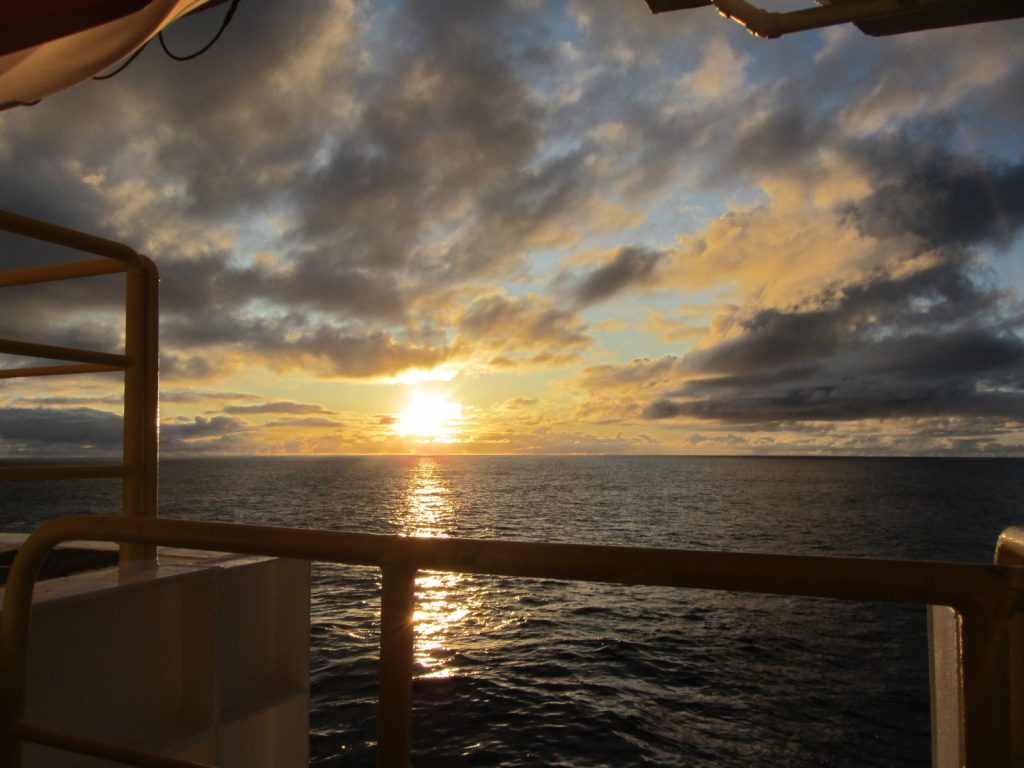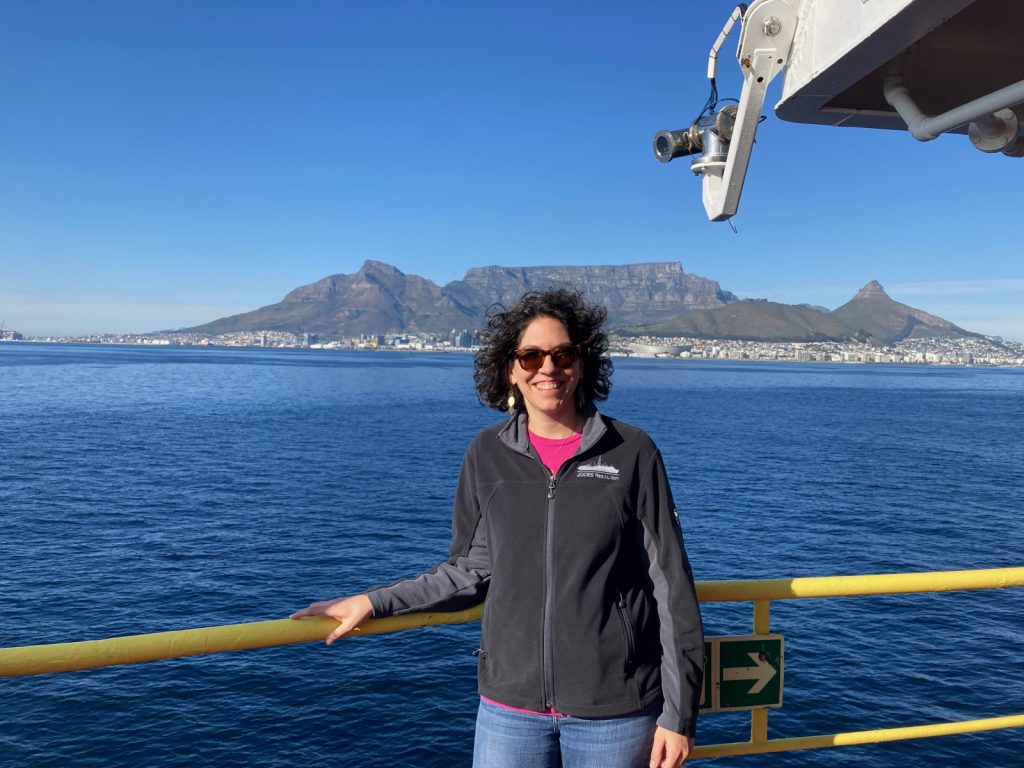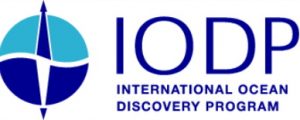Can tiny fossils disrupt global communications?
Microfossils are often smaller than a grain of sand, yet when they accumulate on the seafloor, they can have significant impacts on sediment stability. Dr Julia Reece, a marine geologist at Texas A&M University, USA, believes they may play a role in initiating submarine landslides. These underwater hazards pose threats to coastal communities and global communications, so it is vital to understand how they occur.
TALK LIKE A MARINE GEOLOGIST
Coastal upwelling — deep nutrient-rich water rising to the ocean surface near continents
Consolidation — volume reduction in sediments by the expulsion of fluids in response to a pressure increase
Diatom — a single-celled organism that produces an outer skeleton made of silica
Hydraulic — a system defined by moving fluid in a confined space under pressure
Hydrothermal — heated water
Impermeable — does not allow fluid to flow through
Pore fluid pressure — the pressure acting on fluids in rock or sediment pores (the voids between grains)
Resedimentation — a technique to simulate the natural process of sedimentation and burial under controlled lab conditions
Shear strength — a material property that describes a material’s maximum resistance against shear load before it fails
Shear load — a force that acts parallel to the plane of loading (like when both hands are aligned and moved past one another in opposite directions)
Submarine landslide — an underwater landslide in the ocean
Triaxial compression — compressing a sample in the vertical direction while it is subjected to pressure in all directions
Uniaxial consolidation — compressing a sample in the vertical direction while it is confined horizontally
When you hear the word ‘fossil’, what do you think of? The giant bones of T-rex and stegosaurus? The gracefully coiled spiral of an ammonite? These are the fossils that most of us are familiar with. But fossils come in all shapes and sizes, and many geologists would argue that microfossils are the greatest fossils of all – incredibly small and exquisitely beautiful, not only can microfossils teach us about past climates, but they are extremely useful in our everyday life. You can find them in toothpaste, water filtration systems and cat litter!
What are microfossils?
As their name suggests, microfossils are tiny. “They are often smaller than a grain of sand and can only be inspected with a microscope,” says Dr Julia Reece, a marine geologist at Texas A&M University. In the ocean, single-celled organisms (such as foraminifera, diatoms and radiolarians) produce outer mineral skeletons composed of calcite or silica. When the organisms die, their tiny skeletons sink to the bottom of the ocean where they join the sediment accumulating on the seafloor. Julia believes these microfossils in seafloor sediments may play a role in initiating submarine landslides.
What are submarine landslides?
Submarine landslides occur on the continental margin, the slope that exists between the shallow waters surrounding continents and the deep ocean. If sediment deposited on the seafloor becomes unstable, for example in response to an earthquake, it may collapse as a submarine landslide.
“Submarine landslides pose a significant risk to coastal communities and seafloor infrastructure, as they can generate tsunamis and destroy subsea cables and pipelines,” explains Julia. The seafloor is crossed by a network of cables and pipes, transporting digital data, electricity, oil and gas between countries. If you phone someone across the sea, or send them an internet message, the data will be sent through a cable lying on the seafloor. Despite living in a wireless age, 99% of all data that crosses an ocean travel through a seafloor cable, meaning submarine landslides can impact global connectivity and communication.
How might microfossils initiate landslides?
As microfossils are mineral skeletons that once held single-celled organisms, they are hollow. After the cell dies, the fossil fills with seawater. “Large quantities of microfossils can hold significant volumes of water,” says Julia. “If microfossils are buried by impermeable clay-rich sediments, the clay will trap the water in the layer of microfossils. This would increase the pore fluid pressure and reduce the shear strength of the sediment, potentially creating a weak layer that is more prone to failure.” To test this hypothesis, Julia and her team of researchers in the Sediment Mechanics Lab are conducting experiments and creating numerical models of sediment failure.
Combining lab experiments with numerical models
Julia uses a technique called resedimentation to create samples for her lab experiments. She mixes microfossil-free marine sediment with varying amounts of commercially available diatoms, allowing her to control the exact proportion of microfossils in each sample.
She conducts uniaxial consolidation tests on each sample by vertically compressing them to simulate the natural burial conditions of seafloor sediments. This allows her to determine how the physical, mechanical and hydraulic properties of sediments change as they are exposed to greater stresses. Julia then performs triaxial shear tests on each sample by applying pressure in all directions and loading it (uni)axially until the sample fails. “This tells us the shear strength of the sediment and diatom mixtures, which is a critical parameter in the stability of continental margin sediments,” she explains. Julia also uses high resolution imaging techniques to observe differences in sediment microstructure during these experiments.
Once Julia understands how microfossils influence the stability of sediments in her lab samples, her next challenge will be to scale up these results so they can be applied to continental margins. Using powerful computer software, she will create numerical models of continental margin sediments to analyse their stability. “The results from our lab experiments become the input parameters to these numerical models, as they define the physical, mechanical and hydraulic properties of all sediment layers,” Julia explains. Using her models, she will then test the impact of different factors, such as the thickness of a weak layer, on the stability of a continental margin. “Ultimately, we hope to better understand exactly where failure will occur and under which conditions.”
What data is Julia missing?
“The most accurate and realistic geological understanding is achieved when experimental, numerical and field observations are integrated,” says Julia. Her team is in the process of performing lab experiments to measure the properties of sediments and simulate natural processes on a small scale. Next, Julia will develop numerical models based on the experimental results, enabling her to test large-scale scenarios not possible in the lab. Field studies would allow Julia to compare her experimental and numerical observations with real-life data. A combination of these three approaches is best to understand geological processes.
“To really test our hypothesis, we therefore need to collect sediment cores from a submarine landslide deposit and its undisturbed counterpart that was not caused by an earthquake, but occurred in a coastal upwelling zone, where the abundance of microorganisms is high,” Julia says. During a submarine landslide, the failure plane that initiates the landslide will be destroyed. This means that as well as sampling the material deposited during the landslide, it is equally important to sample the undisturbed sediment on the continental margin, as this will contain the weak layers that may form future failure planes. “Recovering the sediment that comprises these weak layers is crucial for understanding their composition and role in the initiation of slope failure.”
How could Julia sample seafloor sediments?
There are several challenges to sampling seafloor sediments, not least that they are covered by hundreds to thousands of metres of water. This means there is no easy way to access them. Scientific ocean drilling is the only method that can collect them, as research ships can drill sediment cores from the ocean floor and return them to the surface for scientists to study. The second major challenge is that it is a difficult and long process to get scientific ocean drilling projects funded by the International Ocean Discovery Program (IODP). This is hardly surprising when it costs almost $300,000 per day to operate their research ship!
Although Julia has been involved with other IODP missions, the proposal to drill into submarine landslide deposits and continental margin sediments, proposed by her and other international scientists, has not yet been approved. For now, Julia must rely on her lab experiments using natural sediments and numerical models to draw conclusions about the role of microfossils in initiating submarine landslides, helping scientists understand when and where these potentially devastating underwater hazards may occur.
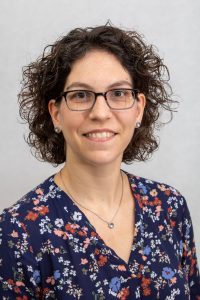 DR JULIA REECE
DR JULIA REECE
Sediment Mechanics Lab, Department of Geology and Geophysics, Texas A&M University, USA
Fields of research: Sediment Mechanics, Marine Geology
Research project: Investigating the role of microfossils in initiating submarine landslides
Funders: US National Science Foundation (NSF, Award # 1945011), US Science Support Office (USSSP). The contents are solely the responsibility of the authors and do not necessarily represent the official views of NSF
ABOUT THE INTERNATIONAL OCEAN DISCOVERY PROGRAM
The International Ocean Discovery Program (IODP) is a marine research collaboration to ‘explore the Earth under the sea’. The IODP uses research ships such as the JOIDES Resolution to drill into the seafloor to collect samples of sediments, the rocks below them, the fluids flowing through them and the organisms living in them. These expeditions generate data allowing scientists to uncover Earth’s geological, climatic and biological history.
Reference
https://doi.org/10.33424/FUTURUM339
The JOIDES Resolution
Sunset, viewed from the port side of the JOIDES Resolution during IODP Expedition 393
What do ocean expeditions involve?
From June to August 2022, Julia sailed on the JOIDES Resolution as co-chief scientist for IODP Expedition 393. “We were interested in how seawater-derived hydrothermal fluids change seafloor sediments and ocean crust over time,” she says. “To study this, we drilled a series of cores along a 930 km-long transect line, perpendicular to the southern Mid-Atlantic Ridge.” As the ship moved further from the ridge, the team sampled ocean crust ranging in age from 7 million to 61 million years. This allowed them to quantify changes in the fluid-sediment-rock interactions and the microbial communities living on and in the seafloor, as well as better understand Earth’s oceanographic and climate history in the South Atlantic Ocean.
“As co-chief scientist, my job was to ensure our scientific objectives were achieved,” says Julia. “It’s extremely rare that everything goes smoothly on a two-month long expedition!” When weather and technical issues disrupted plans, Julia had to be adaptable to ensure the expedition’s time was used efficiently, productively and safely.
Who participates in ocean expeditions?
The JOIDES Resolution carried 106 people during Expedition 393. Of these, 27 were scientists, specialising in a range of fields (including sedimentology, geochemistry, microbiology and micropalaeontology) and supported by 21 technical staff. The ship’s crew performed all the ship’s operations, from navigation to managing the drilling process to providing medical assistance, while caterers supplied meals and laundry for everyone.
What is it like onboard the JOIDES Resolution?
“Every scientist works 12-hour shifts, from noon to midnight, or midnight to noon,” explains Julia. During their shift, scientists work in onboard labs to describe and analyse the drilled core samples that are collected from the seafloor. They also have meetings with team members and write reports on their results.
Meals are at 6am, noon, 6pm and midnight, and nature of the shift pattern means that while some people are eating breakfast, others are eating dinner. “The espresso and ice cream machines quickly become everyone’s favourite!” says Julia. In their free time, scientists might connect with friends and family back home, socialise with others onboard, exercise in the gym or spend time on deck.
What are the joys of ocean expeditions?
“I love being at sea!” says Julia. “It’s peaceful to be surrounded by nature and I’m fascinated by the drilling operations.” Not only did she enjoy learning about the drilling process, Julia also liked being part of a diverse group of people. “No matter where you’re from or what academic level you’re at, everyone works together to achieve the scientific mission of the expedition. I found that very inspiring,” she says. Unfortunately, some people find it harder to adjust to life at sea: “I am lucky that I don’t easily get seasick. If you do, then the start of an expedition may not be as enjoyable!”
Pathway from school to marine geology
• At school, study geography and any additional environmental or Earth science courses that are available.
• At university, degrees in geology, oceanography, Earth science or geophysics could lead to a career in marine geology.
• Julia recommends taking fundamental courses in mathematics, physics, chemistry and biology to ensure you have a strong base knowledge, as well as specialised geology courses in sedimentology, stratigraphy and oceanography. “If, like me, you are interested in the geomechanical behaviour of ocean sediments, I would also recommend taking civil engineering courses in soil mechanics,” she advises.
Explore careers in marine geology
• The National Oceanic and Atmospheric Association (NOAA) features profiles of people working in a range of ocean exploration careers, from marine geologists and geophysicists, to the captains and technicians who keep the research vessels sailing: www.oceanexplorer.noaa.gov/edu/oceanage/welcome.html
• Environmental Science provides information about what work you might do as a marine geologist, the qualifications you will need and the salary you can expect: www.environmentalscience.org/career/marine-geologist
• If you are interested in marine expeditions, check out STEMSEAS (Science, Technology, Engineering and Math Student Experiences Aboard Ships) at Columbia University. This programme allows high school graduates to participate in NSF-funded ocean research expeditions: mlp.ldeo.columbia.edu/stemseas
Meet Julia
What were your interests when you were younger?
I have always loved nature. I grew up near the coast in Germany, where my love for the ocean comes from. At school, I enjoyed STEM subjects the most, while my creative side came through my hobbies which included crafting, drawing and painting. Initially, I wanted to become an architect and I even completed an internship at an architecture firm. Now, I believe my sketching ability and attention to detail are critical skills as I process scientific data and conduct meticulous laboratory work.
Who inspired you to become a geologist?
My high school math, physics and geography teachers sparked my interests in STEM subjects. But it wasn’t until I attended a university open day aimed at women students interested in studying STEM that I knew I wanted to become a geoscientist. That was the first time I learned about geophysics and marine geology, and I was immediately hooked.
What experiences have influenced your career path?
As a student, I believe I gained the most insight and direction from research opportunities and participation in expeditions. Those experiences reinforced my passion for marine geology, increased my confidence and provided critical information to guide my path.
As an undergraduate geoscience student at the University of Bremen in Germany, I had the opportunity to sail on two research cruises, aboard the RV Meteor and RV Polarstern. These expeditions fuelled my love for marine geology and confirmed I was on the correct career path. As a master’s student, I sailed on IODP Expedition 308 in the Gulf of Mexico. One of the expedition co-chief scientists then recruited me as a PhD student, which is how I ended up in the US. My PhD research used IODP data and samples, so my involvement in the programme grew from there.
What are your favourite IODP expedition memories?
I have so many good memories of my time at sea! It was exhilarating to see new cores pulled up from the ocean floor and lay our eyes on sediment no one had ever seen before. We had fun onboard, with BBQs on deck and a special feast for US Independence Day. Watching whales, sunsets, night skies and bioluminescence were all amazing experiences. Finally, I will never forget the onboard memorial service we had to celebrate the life of Professor Dick Kroon, a leader in the scientific ocean drilling community, who passed away just before our expedition. It was a very emotional and memorable moment.
What are your research plans for the future?
I look forward to analysing all the samples that I came home with and synthesising the information we collected, during and post-expedition, with the entire science team. While I am happy to be back on land after two months at sea, I hope to sail again someday so I can answer some of our outstanding questions about submarine landslides, by drilling through them and their undisturbed counterparts.
Julia’s top tips
1. Be proactive and talk to professors
2. Seek out new experiences and opportunities
3. Enjoy what you are doing and be proud of it!
Do you have a question for Julia?
Write it in the comments box below and Julia will get back to you. (Remember, researchers are very busy people, so you may have to wait a few days.)


